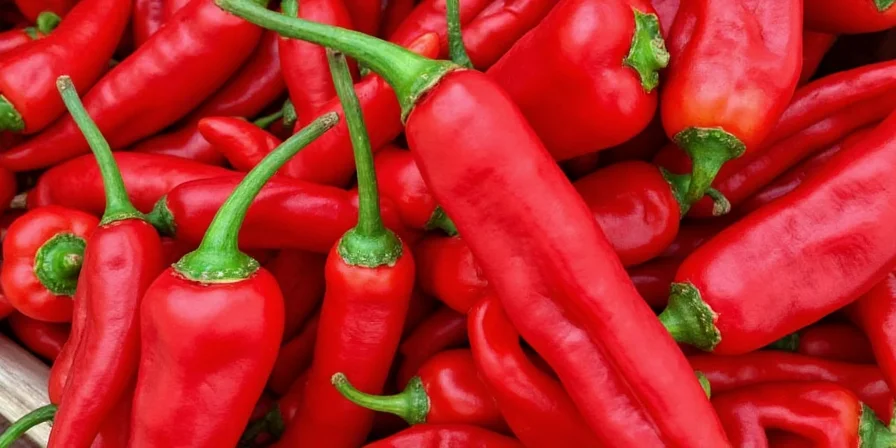If you're looking to add authentic Chinese heat to your cooking, Tien Tsin chile peppers are your secret weapon. These small but mighty dried peppers deliver the complex, building heat that defines classic Sichuan and Hunan dishes. Unlike generic red pepper flakes, Tien Tsin peppers provide nuanced flavor with earthy, floral notes and a distinctive warmth that enhances rather than overwhelms your dishes.
What Are Tien Tsin Chile Peppers? Your Quick Reference
Tien Tsin chile peppers (also spelled Tianjin or Tean Tsien) are small, thin dried chilies essential to authentic Chinese cooking. They're not just 'hot'—they bring layered complexity that transforms simple dishes. Here's what you need to know immediately:
- Heat level: Medium-high (30,000-50,000 Scoville units) - hotter than jalapeños but milder than Thai bird's eye chilies
- Flavor profile: Earthy with subtle floral notes and a slow-building warmth
- Where to find them: Asian grocery stores (look in dried spice sections), online spice retailers, or well-stocked supermarkets
- Perfect substitute: Mix 3 parts mild Aleppo pepper + 1 part cayenne for closest approximation
Tien Tsin vs. Common Dried Chilies: What Home Cooks Need to Know
| Pepper Type | Size | Heat Level | Flavor Notes | Best Uses for Home Cooks |
|---|---|---|---|---|
| Tien Tsin | Small, slender (~2-4") | Medium-High | Earthy, floral, slightly smoky | Stir-fries, chili oils, braises |
| Ancho | Large, broad | Mild | Sweet, fruity, deep | Mole sauces, stews |
| Guajillo | Moderate, elongated | Mild-Medium | Berries, tea-like, tangy | Salsas, marinades |
| Cayenne | Slender, medium length | High | Sharp, pungent | Spice blends, powders |
| Thai Bird's Eye | Very small, roundish | Very High | Grassy, citrusy, immediate heat | Curries, salads |





Why Tien Tsin Peppers Work Better Than Regular Red Pepper Flakes
Regular red pepper flakes lack the nuanced flavor of authentic Tien Tsin peppers. Here's what makes them special for home cooking:
- Gradual heat release: Unlike Thai chilies' immediate burn, Tien Tsin peppers build warmth that integrates with other flavors
- Texture advantage: Their brittle structure allows precise control - break them into pieces for milder heat, crush for more intensity
- Flavor preservation: Whole peppers maintain volatile compounds that give authentic Chinese dishes their characteristic aroma
- Oil compatibility: They infuse beautifully into oils without becoming bitter (unlike many substitutes)
3 Simple Techniques Every Home Cook Should Know
- The Cold Start Method: Add whole peppers to cold oil, then heat slowly to 325°F. This extracts flavor without bitterness - perfect for quick stir-fries
- The Quick Bloom: Soak 5-6 peppers in 1/4 cup hot water for 10 minutes, then use both peppers and liquid in braises for instant flavor depth
- The Toast & Crush: Dry-toast peppers in a skillet for 60 seconds until fragrant (not blackened), then crush for seasoning roasted vegetables or meats
Where to Buy & How to Store for Maximum Freshness
Finding authentic Tien Tsin peppers:
- Look for deep red (not orange) color with some flexibility (not brittle)
- Reputable brands: Lee Kum Kee, Spicely Organics, or store brands from Asian grocery stores
- Avoid packages with excessive broken pieces or dust at the bottom
Storage tips that work:
- Keep in airtight container away from light (dark glass jar ideal)
- Store in cool, dry place (not next to your stove!)
- Properly stored, they'll maintain flavor for 12-18 months (vs 3-6 months for ground alternatives)
- Don't refrigerate - moisture causes flavor loss
Beginner-Friendly Tien Tsin Pepper Recipes
5-Minute Restaurant-Style Chili Oil
Heat 1 cup neutral oil (like canola) to 325°F. Add 15 Tien Tsin peppers and 1 tsp Sichuan peppercorns. Cook 2 minutes until peppers darken slightly. Remove from heat and let steep 15 minutes. Strain and use immediately for noodles, dumplings, or as dipping sauce base.
Simple Kung Pao Tofu (30 minutes)
Stir-fry cubed tofu until golden. Remove and set aside. In same pan, heat 2 tbsp oil with 8 Tien Tsin peppers and 1 tbsp minced ginger until fragrant (1 min). Add tofu, 1/4 cup soy sauce, 2 tbsp rice vinegar, and 1 tbsp sugar. Simmer 5 minutes until sauce thickens. Garnish with green onions.
Advanced Techniques for When You're Ready to Level Up
Once you're comfortable with Tien Tsin basics, try these professional methods:
- Three-Temperature Infusion: Create layered chili oil by adding peppers at 200°F, 250°F, and 300°F to capture different flavor compounds
- Vinegar Soaking: Soak peppers in rice vinegar (not water) before use to preserve pH-sensitive flavor molecules
- Seed Utilization: Keep seeds intact for oil infusions where heat compounds are oil-soluble, but remove for dry applications
- Heat-Modulated Cooking: Fry eggplant with chilies at precise 350°F oil temperature for controlled flavor infusion
Frequently Asked Questions
Can I substitute Tien Tsin peppers in Szechuan chicken?
Yes, but with adjustments. Use 1 part cayenne + 3 parts mild Aleppo pepper for closest heat profile. Add a pinch of smoked paprika for the subtle smokiness Tien Tsin provides.
Why do my Tien Tsin peppers taste bitter?
Most common mistake: overheating. Never exceed 350°F when toasting or infusing. Professional kitchens use the 'flick test' - if a drop of water sizzles but doesn't immediately vaporize, the oil is at perfect 325°F for Tien Tsin.
How many Tien Tsin peppers equal one teaspoon of red pepper flakes?
Generally, 5-6 whole Tien Tsin peppers crushed equals 1 tsp red pepper flakes. But remember - Tien Tsin provides more complex flavor, so you may want to use slightly less for equivalent heat.
Do Tien Tsin peppers lose potency over time?
Yes, but slower than ground alternatives. Whole peppers maintain 80% potency for 12-18 months when stored properly, versus 3-6 months for ground spices. Test freshness by rubbing a pepper between your fingers - fresh ones should release a strong, floral aroma.











 浙公网安备
33010002000092号
浙公网安备
33010002000092号 浙B2-20120091-4
浙B2-20120091-4